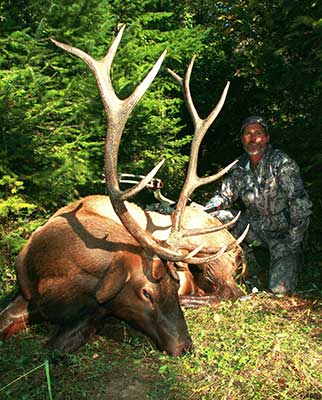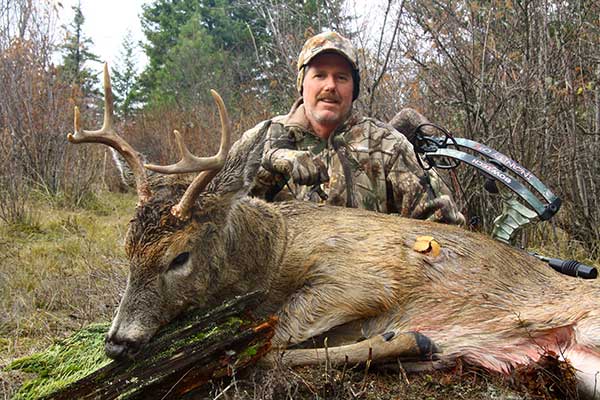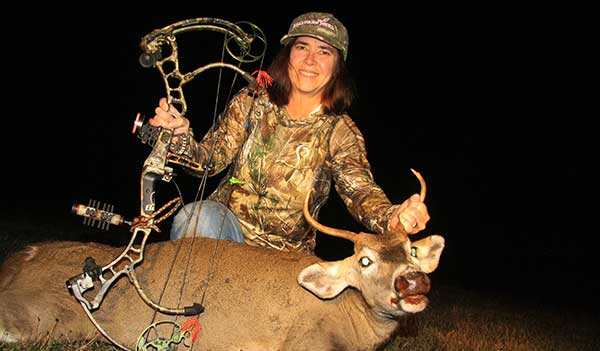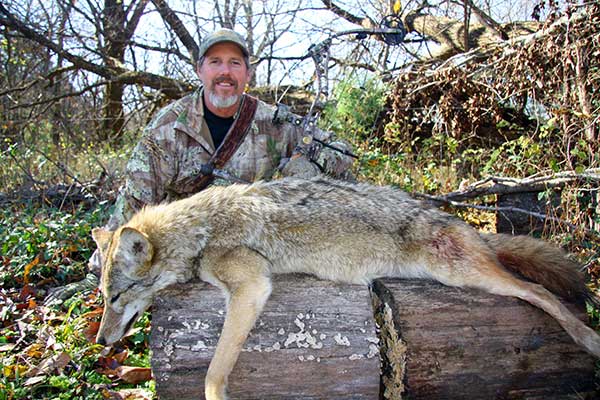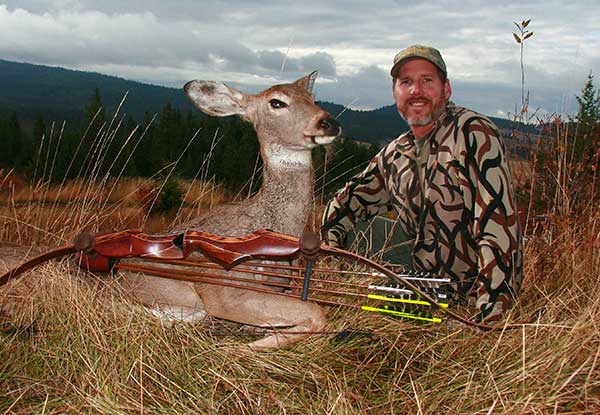LAST UPDATED: February 25th, 2020
The question really boils down to this: Who are you really hunting for?
The question of what defines a trophy is a fairly recent phenomenon particular to the times we live in. It was once an easy one; or allowing (if I may) the late Fred Bear to answer for me: “Any animal taken fairly with bow and arrow is a trophy.” There was a time when this was the standard mantra. At least back in the late 1970s when I started bowhunting with recurve bows. Of course the recurve bow portion of that equation was a big part of that attitude, as it certainly was back in Papa Bear’s day. Today we seem more inclined to allow mass media, peer pressure, industry experts and the privileged classes dictate what is to be considered a trophy.
Modern compounds (more recently crossbows), laser rangefinders and other assorted space-age gear have certainly made bowhunting much easier than it was. General success rates have climbed as a result. But the argument could also be made that as technology has advanced game was kept pace by becoming ever more cautious. To wit: When I started bowhunting it wasn’t uncommon to receive multiple shots at a single animal. My first bull elk — a New Mexico 6×6 — was taken on the second shot, the first used as a “ranging shot” (pre laser rangefinders), the second put in the boiler room. That doesn’t happen too often today. Miss an animal in the New Millennium and he’s more likely to plow a swath through tangled woods vacating the vicinity than curiously stand and welcome another poke. And if the notion of game becoming increasingly wary as we continually increase our lethality is true, it really is a pretty sad testament to how far things have “progressed.” At least it is for me, the “old timer pining for the good old days.”
But we certainly can’t place all the blame regarding redefined definitions of trophy quality wholly on modern equipment. There’s a particular phenomenon in whitetail hunting (in particular) I find quite distressing; the modern “whitetail expert.” Today, when everything from cooking (think “Iron Chef”) to whitetail hunting is rendered into an ego-based contest, “expert” translates into anyone who kills the biggest bucks and most often. Not surprisingly, these “experts” are almost entirely based in a handful of Midwestern states; Iowa, Kansas, Missouri, Illinois and Wisconsin.
Trophy quality is most often relative. While living in New Mexico’s Gila Monster elk region author Patrick Meitin would never have given this bull a second glance. After moving to North Idaho he worked his tail off to get a shot at a bull this size.
Not incidentally, the states used as examples also happen to relinquish the highest numbers of record-book bucks annually. No mystery there. Tightly-controlled firearms hunting, abundant and highly-nutritional food and superior genetics combine to produce superior bucks. Translated further this also means bigger antlers at younger ages. It’s like claiming to be a champion largemouth bass fisherman because you reside on the shores of Florida’s Lake Okeechobee while “competition” is relegated to northern farm ponds.
Consider a whitetail state such as Minnesota, which has the food and genetics, but also intense rifle-hunting pressure through the heart of the rut. Minnesota could produce big bucks (and it does a handful every season), but few survive past 3 ½ years old. A rut interrupted by copious rifle blasts is bowhunting’s biggest spoiler. Then there are places like the Deep South, just for instance, a region harboring plenty of deer but noticeably few big antlers (by Midwest standards). Limit hunting all you want, feed them well, but outside statistical anomalies they’ll never grow Booner antlers.
Author Patrick Meitin had some monster big-woods bucks on his radar but due to one thing or another it just didn’t come together. With the season dwindling to a close he chose to take this average buck. The time and hard work invested ultimately makes it a trophy.
The entire record-book thing might also be considered part of the sickness. I understand that to make the entire program operate boundaries and minimum scores for various species must be established, while also attempting to condense the whole mess into manageable parameters (I mean, arguments could go on for decades as to which subspecies of deer deserves special consideration and record-book status). But it does create a situation amidst all this trophy hysteria where you’ve pit those living in, say, Iowa or Kansas (easy examples) — where 2 1/2 –year-old bucks regularly score more than 125 inches (Pope & Young Club’s whitetail minimum) — against someone living in, say, Alabama or New Jersey (again quick examples), where few bucks grow such antlers under the best of conditions, never mind that if a buck did possess the genetics needed to do so he would be required to dodge bullets 3 to 4 years to reach that potential… The backyard weekend warrior who makes up the largest percentage of bowhunters nationwide has no control over available genetics and especially not the negative impacts stemming from poor game management in his state or region.
My real gripe in that regard is not that my backyard whitetail hunting isn’t as good as certain Midwestern states, but the notion that’s been force-fed the hunting public saying no matter where you hunt, no matter how poorly managed your regional deer herds, how scanty feed, how lackluster genetics, you, too, can tag a trophy buck — if you’ll only follow the advice dispensed by one of the established whitetail gurus. Failing to do so, of course, means you’re simply not as savvy as the in-house authority. Which begins to seem a bit self serving; i.e. “I know something you don’t so keep buying my magazine/products/services and get with the program, loser.”
It’s also sad to watch bowhunters who once thoroughly enjoyed “average” backyard bowhunting on its own merits grow ever more disillusioned because they can’t keep pace with Bowhunting’s Fortune 500. These working stiffs hunt hard and smart in the time available to them, give it their all, but can’t even began to touch the unrealistic benchmarks set by industry insiders. I can’t attend a single sports show without witnessing the ugliest aspects of this via ever-present antler bullies. A guy tags a public-lands trophy (of whatever species) in some non-heralded place, is rightly proud as punch and has the audacity to show a group of fellas his trophy photo. Which is immediately trumped, like a childhood card game of War, with a slap-down of a dozen trophies making his look ridiculous.
Author Patrick Meitin says this is one of his fondest trophies of all time. Yes, his wife (shown here with her Idaho whitetail buck), but also because this was his wife’s first whitetail buck. She took the buck completely on her own while the author was away at work.
Bragging rights today (ironically enough for some of us) comes not only in raw scores (likely inflated due to the insecurities antler bullying inflicts) but by also pointing out the animal was taken on a property/guided hunt you couldn’t begin to afford. Industry pro staffs are well tenanted by multimillionaires who spend so much money on pricey outfitted hunts they apparently can’t afford to purchase their own equipment.
In the big picture it seems it would be much more useful, and interesting, to learn how a blue-collar bowhunter from Georgia, New Jersey, Michigan or Pennsylvania – just for instance – regularly tags 125-inch bucks from hard-hunted public lands, than hearing about another jetsetter privy to the best hunting opportunities and unlimited time who just made another acquisition for his Super Slam. This has absolutely nothing to do with sour grapes (I would do the same given their situation), just an honest thirst for useful information an average DIY guy like myself can actually make use of.
A reality check really seems indicated. And I admit it has been a slow dawning for me.
While still young the outdoors and bowhunting came to represent how I related to the world at large; owning a bow by 10, killing a handful of rabbits with it after a couple years concerted effort, and then my first deer at 14. Bowhunting slowly came to define me.
After high school I became a big-game guide and was lucky enough to hunt with several of my bowhunting heroes. By “heroes” I mean I’d read and studied their writings hoping to glean as much useful information as possible. It was then shocking to learn many of them actually needed my services. One of these guys, the editor of a small archery magazine, invited me to submit a few articles. It wasn’t long before I was one of those regularly dispensing that sage advice.
Something had been lost. I’d lost sight of those early days as a bowhunter when I tagged only the occasional animal. Each triumph was a celebration. I bought a compound after escaping high school and began to find regular success. I slowly learned more about bows and shooting them until bowhunting success came so frequently as to seem nearly automatic; eventually turned into a series of check-points in a contest with peers — a wrap to a successful television show, pictures for the next magazine article, a blur of lolling tongues and glazed eyeballs eventually causing me to step back and take a hard look.
I’m trying hard to hunt for myself again. I find myself shooting recurves more often (though haven’t abandoned compounds by any means), not because they make me feel superior in any way but because they bring me great joy. Tagging any game with my recurves brings back those old feelings of having truly accomplished something, making each triumph a celebration. So this, after all these years, has come to represent what a true trophy is for me. I do not require that you adopt my standards, or concur, or even give me the slightest nod of approval.
This is all author Patrick Meitin has to show after a week in prime Kansas whitetail habitat. In bowhunting you take the good with the bad, while other times it helps to keep things in perspective and appreciate the smaller prizes that come your way.
My success is no longer measured in record-book scores, though some old habits die hard. I might tell you I hunt the biggest animals possible to prolong the excitement of the chase, as after all, filling my tag does mean I’m done for the season. There’s no escaping the fact big antlers, skulls and horns still fascinate me, it’s just they’re no longer required to make my life whole. The old adage of “A trophy is in the eye of the beholder” has never been truer for me. I strive to bowhunt on my own terms even if that means satisfaction with an eating-fat doe or hard-earned buck with smallish antlers (which I now refuse to debase with the label “Management Buck”), or just a cottontail rabbit taken during an afternoon stroll.
The question of what constitutes a trophy is ultimately for you to decide — and absolutely no one else.
Perspective is everything when considering what defines a trophy. Author Patrick Meitin considers this one of his finest trophies, because it was the very first deer he took on his own property, with recurve and while still-hunting afoot.

 By
By 